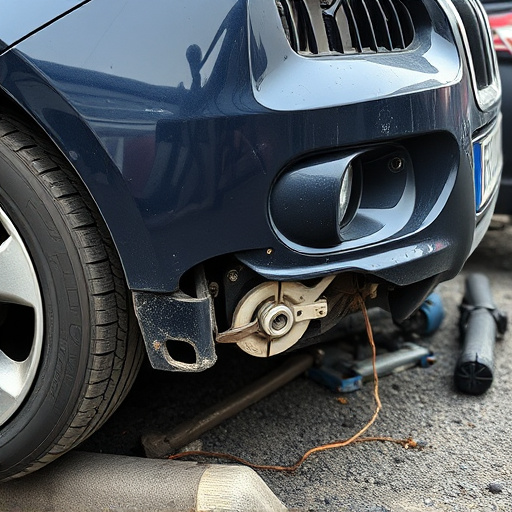When to Prioritize Frame Damage Assessment Immediately

Frame damage, often invisible, can be significant after car accidents. Regular assessments are cruci…….
Frame damage assessment is a critical process that involves evaluating and quantifying the structural integrity of buildings, particularly focusing on their frames—the skeletal framework that supports the overall structure. This comprehensive assessment method has become an indispensable tool in the construction, insurance, and risk management sectors, ensuring the safety and value of built environments. The article aims to guide readers through the intricate world of frame damage assessment, exploring its various facets, global implications, and future prospects. By the end, readers will understand why this practice is not just a technical procedure but a vital component in shaping safer and more resilient communities.
Definition:
Frame damage assessment refers to the systematic process of examining and analyzing building frames to identify defects, deteriorations, or damage that may compromise their structural performance. It involves a detailed inspection, often utilizing advanced technologies, to assess the frame’s current condition and predict its long-term behavior under various loading conditions.
Core Components:
Visual Inspection: The initial step includes a thorough visual examination of the building exterior and interior, focusing on visible signs of damage or distress in the framing system. This involves checking for cracks, deformations, rot, or any unusual findings.
Non-Destructive Testing (NDT): NDT methods are employed to evaluate frame integrity without causing permanent damage. These include techniques like ultrasonic testing, ground penetration radar, and thermography to detect internal defects, corrosion, or structural anomalies.
Structural Analysis: This involves complex calculations using engineering principles to determine the frame’s capacity to withstand loads. Engineers utilize software tools to model the structure and predict its response under different scenarios, ensuring compliance with building codes and regulations.
Reporting and Recommendations: The assessment concludes with a comprehensive report detailing the findings, including damage extent, causes, and recommended repair or reinforcement strategies. This information is crucial for informed decision-making.
Historical Context:
The concept of frame damage assessment has evolved over centuries as construction techniques and building codes advanced. Historically, structural integrity was assessed through visual inspection and experience, which often led to underestimation of risks. With the rise of modern engineering practices in the late 20th century, more rigorous assessment methods emerged, incorporating scientific principles and advanced technologies. Today, this practice is standardized and regulated, ensuring a more accurate and consistent approach.
Frame damage assessment has left a significant global footprint, shaping construction practices and safety standards worldwide. Its impact varies across regions due to differing climatic conditions, building codes, and cultural approaches to risk management.
North America and Europe:
These regions have long been at the forefront of adopting advanced frame damage assessment techniques. Strict building codes and a history of implementing rigorous structural safety measures have led to well-defined protocols. For instance, in the US, the International Building Code (IBC) provides guidelines for assessing wood and steel frame structures, ensuring regular inspections and maintenance.
Asia Pacific:
The rapid urbanization and construction boom in countries like China, India, and Japan present unique challenges and opportunities. While these regions are adopting modern assessment practices, they also face the daunting task of assessing vast existing infrastructures. Governments are increasingly investing in digital tools and training to enhance frame damage assessment capabilities.
Middle East and Africa:
In these regions, climate conditions often pose significant challenges, with extreme temperatures and high humidity levels affecting building materials. As a result, there is a growing emphasis on moisture-related damage assessment and the use of durable framing materials. Some countries are also implementing mandatory retrofitting programs to strengthen older structures.
The economic aspects of frame damage assessment are multifaceted, influencing both the construction sector and insurance industries.
Market Dynamics:
Investment Patterns:
Economic Impact:
The economic value of frame damage assessment is substantial, contributing to:
Technological innovations have revolutionized frame damage assessment, enhancing efficiency, accuracy, and accessibility.
Advanced Imaging and Data Analytics:
Non-Destructive Testing (NDT) Innovations:
Digital Twin Technology:
Creating digital replicas of physical buildings, digital twins offer a powerful tool for predictive maintenance. By integrating real-time data from sensors, these models can anticipate potential frame damage and suggest proactive measures.
Government policies and regulations play a pivotal role in governing frame damage assessment practices, ensuring public safety and guiding industry standards.
Building Codes and Standards:
Many countries have enacted comprehensive building codes that dictate construction practices, including frame assessment requirements. For instance, the National Construction Code (NCC) in Australia outlines specific guidelines for regular assessments of timber-framed buildings. Similarly, the European Standard EN 1990 provides a framework for structural design and assessment.
Insurance Industry Regulations:
Insurers often collaborate with regulatory bodies to establish risk assessment protocols. These guidelines help set policy terms, premium rates, and claim settlements, ensuring fair practices across the industry.
Data Privacy and Security:
With the increasing use of digital tools, data privacy and security have become critical considerations. Governments are implementing regulations to protect sensitive building information, ensuring confidentiality during assessments.
Despite its numerous benefits, frame damage assessment faces several challenges that require strategic solutions.
1. Skilled Labor Shortage:
The demand for highly skilled assessors and engineers often exceeds supply, leading to delays and potential quality issues. Addressing this requires investment in training programs and incentivizing professionals to enter the field.
2. Cost Implications:
Initial assessment costs can be high, especially for large or complex structures. This may deter some property owners from conducting regular assessments. Subsidies, tax incentives, or insurance-based models could encourage more widespread adoption.
3. Data Interpretation and Standardization:
Interpreting NDT data and other assessment findings requires expertise. Inconsistencies in reporting and lack of standardization across regions can lead to challenges in comparing results. Establishing standardized protocols and promoting knowledge sharing can mitigate these issues.
4. Weather and Accessibility Limitations:
Assessments often face logistical hurdles due to adverse weather conditions or difficult building access. Developing climate-resilient assessment methods and utilizing advanced remote sensing technologies can overcome some of these obstacles.
Case Study 1: Retrofit Program in Japan
Japan’s extensive earthquake history has driven the implementation of mandatory retrofit programs for older wooden frame buildings. The government’s initiative involved comprehensive frame damage assessments, followed by targeted reinforcement and repair works. This program significantly improved the seismic resilience of urban areas, showcasing the impact of systematic assessment and retrofitting.
Case Study 2: Digital Assessment in New York City
New York City’s Department of Buildings introduced a digital assessment platform, allowing property owners to upload images and data for initial frame damage evaluations. This technology streamlined the process, reduced paperwork, and improved communication between assessors and building managers. The platform’s success led to further integration of digital tools across the city’s construction industry.
Case Study 3: Community-Based Assessment in Kenya
In rural Kenya, a non-profit organization initiated a community-based frame damage assessment program to address the lack of resources for regular inspections. Local volunteers were trained to conduct basic assessments using mobile applications, enabling early defect detection and community engagement in structural safety. This model demonstrated the potential for community empowerment in disaster risk reduction.
The field of frame damage assessment is poised for further growth and transformation, driven by emerging technologies and evolving global trends.
Digitalization and Data Analytics:
Sustainability and Green Building:
Global Collaboration and Standardization:
Frame damage assessment is a critical component in ensuring the safety, resilience, and longevity of buildings worldwide. Its evolution from traditional methods to advanced digital technologies has brought about significant improvements in structural integrity monitoring. As the construction industry continues to adapt to changing global dynamics, this practice will remain essential in shaping safer communities. By addressing challenges, adopting new technologies, and fostering international collaboration, frame damage assessment can unlock a future where buildings are not just structures but safe havens designed to withstand the tests of time and nature.
Q: How often should a building’s frame be assessed?
A: The frequency depends on various factors, including local regulations, building age, location, and structural type. Generally, older buildings or those in high-risk areas should undergo assessments annually or as recommended by engineers.
Q: Can digital assessments replace traditional visual inspections?
A: Digital tools excel at data collection and initial screening but often require follow-up visual inspections for detailed defect analysis. Combining both approaches provides the most comprehensive assessment.
Q: What role does insurance play in frame damage assessment?
A: Insurance companies use assessment reports to determine premium rates, claim settlements, and risk management strategies. Regular assessments help policyholders protect their investments and ensure fair treatment.
Q: How can I choose a qualified frame damage assessor?
A: Look for assessors with relevant certifications, experience, and a proven track record. Check if they adhere to industry standards and local building codes. Recommendations from professionals or reputable organizations can also guide your selection.

Frame damage, often invisible, can be significant after car accidents. Regular assessments are cruci…….

Frame damage assessment is vital for accurate vehicle repairs. Skilled technicians use visual inspec…….

A frame damage assessment is a crucial step in vehicle repair after a collision, ensuring structural…….

Frame damage assessment is a meticulous process using advanced tools like laser scanners and CAD sof…….

Frame damage assessment involves scrutinizing vehicle unibody structure for bends, cracks, and twist…….

Accurate frame damage assessment is crucial for effective collision repair and vehicle safety. It in…….

Frame damage assessment is vital for vehicle safety, as even subtle distortions can affect handling…….

Advanced imaging technologies and structural analysis software have revolutionized frame damage asse…….

Frame damage assessment is a critical process in collision repair, ensuring vehicle safety and struc…….

Early frame damage assessment is crucial for cost-saving repairs, enhancing vehicle safety, and stre…….